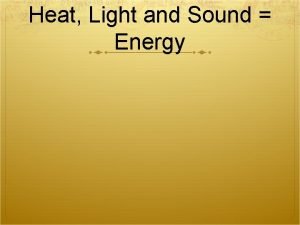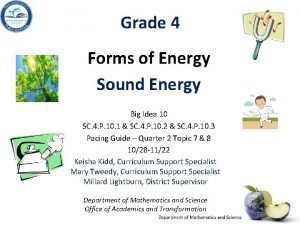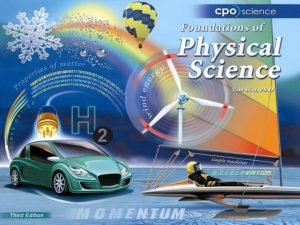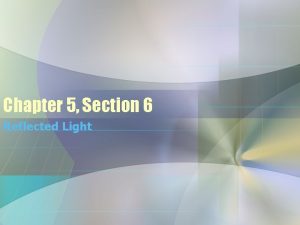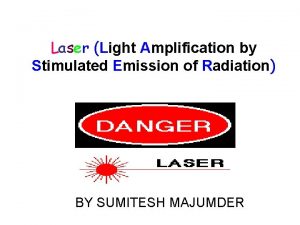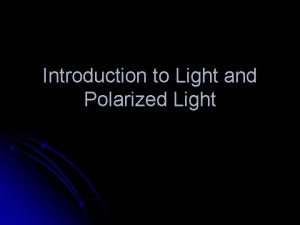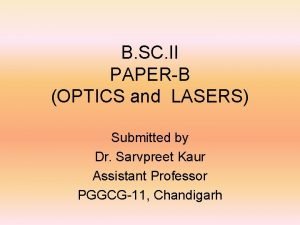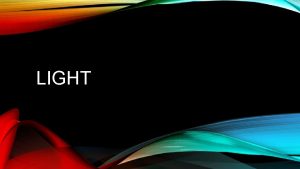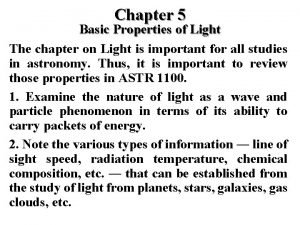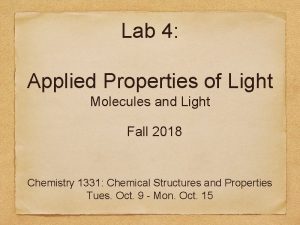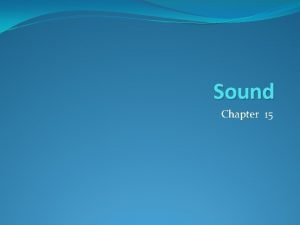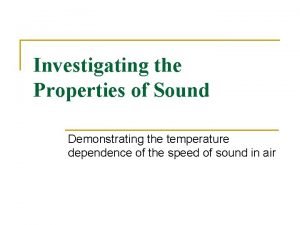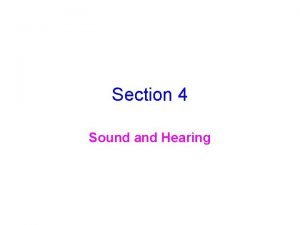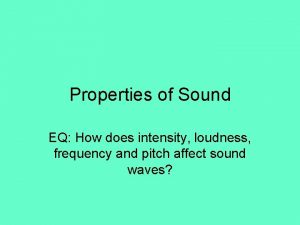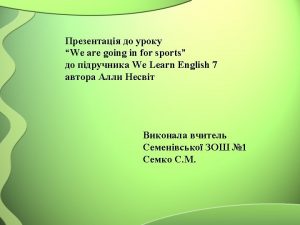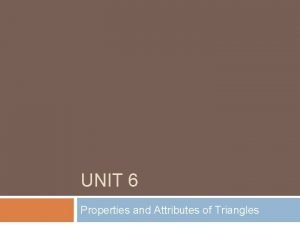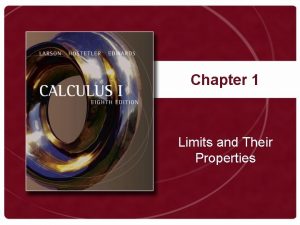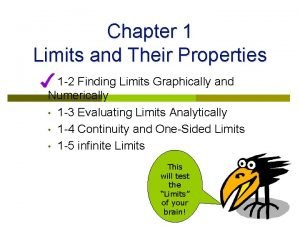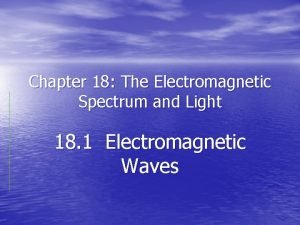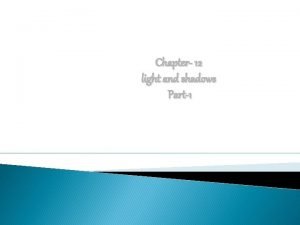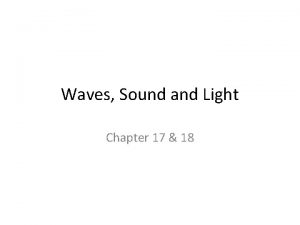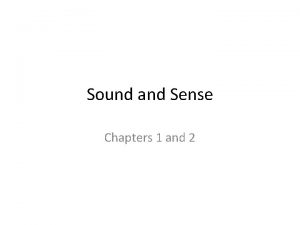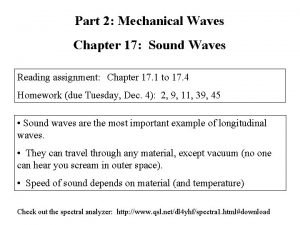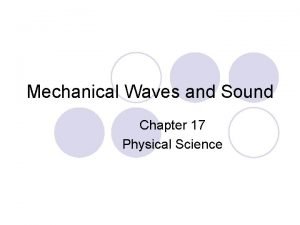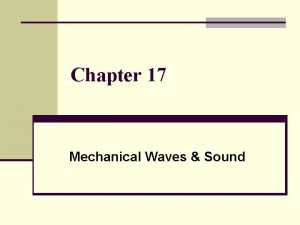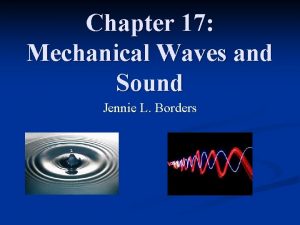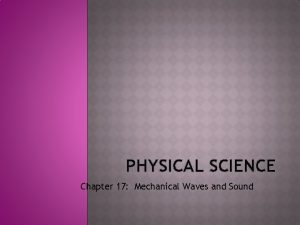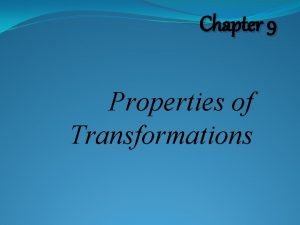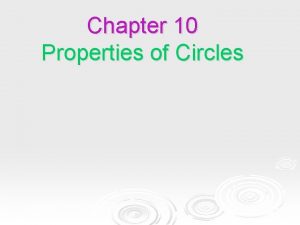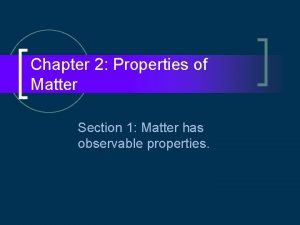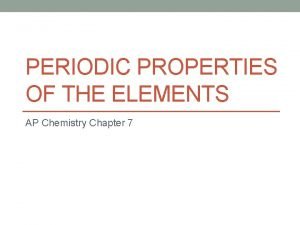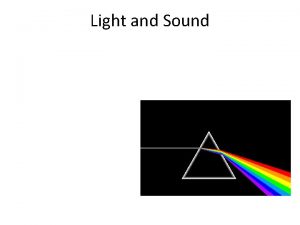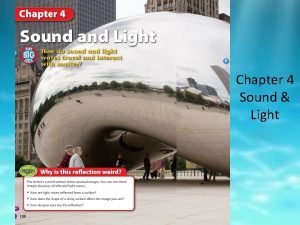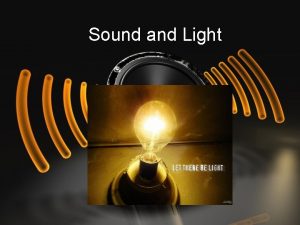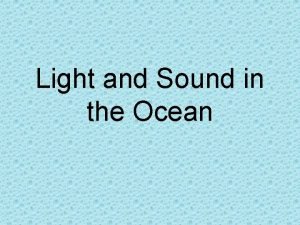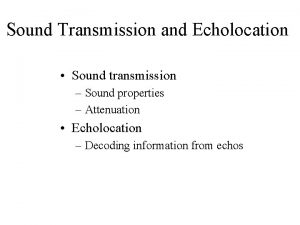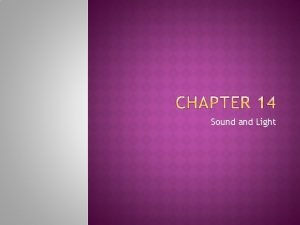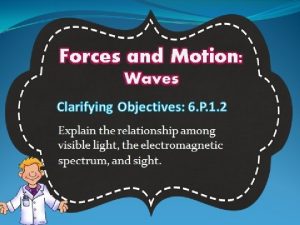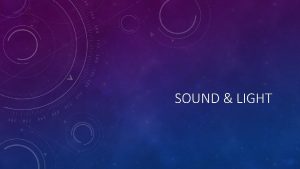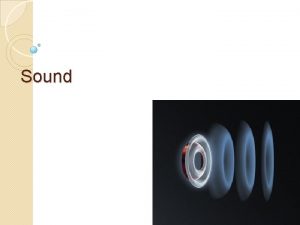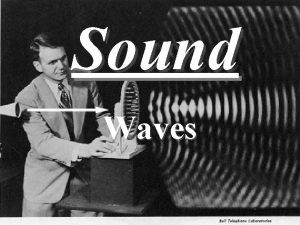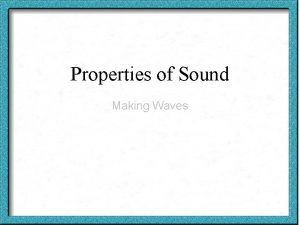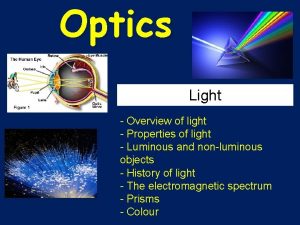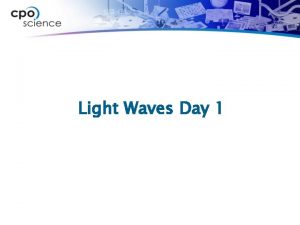Chapter 12 Sound and Light Properties of Sound





















































- Slides: 53

Chapter 12 Sound and Light

Properties of Sound • Sound comes from different sources. • All are longitudinal waves produced by vibrating objects.

• Sound waves are caused by vibrations and carry energy through a medium. • Sound waves in air spread out in all directions away from the source.

Speed of Sound • Speed of sound depends on the medium. • Sound waves travel very fast, but not infinitely fast. • The speed of sound in air at room temperature is about 346 m/s (760 mi/h)

• Sound waves travel faster through liquids and solids than through gases. • Some solids, such as rubber, dampen vibrations so that sound travels very slowly. • Materials like rubber can be used for soundproofing.

Loudness • Loudness is determined by intensity • Loudness depends partly on the energy contained in the sound waves. • Loudness also depends on the distance from the source of the sound waves. • Intensity of a sound describes its loudness at a particular distance from the source of the sound.

• Humans perceive loudness on a logarithmic scale. • Means: sound seems twice as loud when its intensity is 10 times the intensity of another sound. • Relative intensity – compares the intensity of a sound with the intensity of the quietest sound a person can hear.

• Relative intensity is measured in units called decibels (d. B) • Quietest sound to humans is 0 d. B. • 120 d. B is at the point of causing pain. • Sound louder than this hurts your ears and gives people headaches. • Extensive exposure to sound above 120 d. B can cause permanent deafness.

Pitch • Pitch is determined by frequency. • Pitch describes how high or low a note sounds to musicians. • The pitch is related to the frequency of sound waves. • Smaller instruments generally produce higher-pitched sounds. • High-pitched sounds corresponds to high frequency while low-pitched sounds correspond to low frequency.

Humans and Sound Waves • Humans can hear sound from sources that vibrate slowly as 20 vibrations per second (20 Hz) to 20, 000 Hz. • Infrasound: Any sound consisting of waves with frequencies lower than 20 Hz. • Ultrasound: any sound consisting of waves with frequencies above 20, 000 Hz.

• Resonance: an effect in which the vibration of one object causes the vibration of another object at a natural frequency. • Example: The sound produced by a guitar when the forced vibrations (plucking of strings) cause the body of the guitar to vibrate at a natural frequency.

Hearing and the Ear • Vibrations pass through three regions of the ear: outer, middle, and inner. • Sound strikes the eardrum causing vibrations.

Ultrasound and Sonar • Sonar is used for underwater location. • Sonar systems determine the distance by measuring the time it takes for sound waves to be reflected back from the surface. • Average speed of the sound waves in water = v, the distance, d, can be calculated using the speed equation from 8. 1 d = vt

• Ultrasound imaging is used in medicine. • Echoes of very high frequency ultrasound waves (between 1 million and 15 million Hz) are used to produced computerized images called sonograms.

Advantages • Advantages to using ultrasound is that the waves can pass through most materials. • It does not harm living cells like X-rays can.

The Nature of Light • Waves and Particles are two of the most common ways of describing light. • Light produces interference patterns like water • Thomas Young was credited with an experiment to test the nature of light. • Experiment showed light as ripples. (like water)

Light as a Model • Light waves are transverse and do not need a medium to travel. • Light waves are electromagnetic waves because they consist of changing electric and magnetic fields. • Light waves may reflect when they meet a mirror, refract when they pass through a lens, or diffract when they pass through a narrow opening.

The Unexplained • Some observations cannot be explained with the wave model of light. • When light strikes a piece of metal, electrons may fly off the metal’s surface. • Some experiments show that in some cases, dim blue light may knock of some electrons off a metal plate while very bright red light cannot knock off any electrons. (p. 400)

Light as a Stream of Particles • A packet of blue light carries more energy than a packet of red light, which is enough to knock an electron off a plate. • Photons or particles of light, are unlike particles of matter. • Photons have no mass and are considered as bundles of energy which are located in a particular place.

The Situation • Light has a “dual nature” which depends on the situation. • Light is also considered a form of energy. • Each photon of light can carries a small amount of energy. • Amount of energy is proportional to the frequency of the corresponding electromagnetic wave.

Speed/Medium • • • In a vacuum, light travels at the same speed. This is called c. The speed of light is very large. 3 x 108 m/s (about 186, 000 mi/s) Light is the fastest signal in the universe. Light travels through transparent mediums (air, water, and glass) • When light passes through a medium slower when out of a vacuum.

Intensity • Intensity: The rate at which light or any other form of energy flows through a given area of space. • Intensity decreases as the light spread out.

Electromagnetic Spectrum • The electromagnetic spectrum consists of light at all possible energies, frequencies, and wavelengths. • Our eyes can detect light waves ranging from 400 nm (violet light) to 700 nm (red light).

Electromagnetic Spectrum Parts

Pages 403 - 405 • • Repeats 12. 1 Sunlight contains ultraviolet (UV) light. X-rays and gamma rays are used in medicine. X-rays and gamma rays have very high energies so they may kill living cells or turn them into cancer cells. • Gamma rays are also used to treat cancer by killing diseased cells.

Pages 403 – 405 Cont. • Infrared (IR) light • Microwaves • Radio waves

Radar • Radar is a system used to reflect radio waves to determine the distance to, and location of, objects. • Long range use by air-traffic control towers (airports) • Short range: the original signal sent by the antenna may reflect off the plane to a computer that calculates the distance to the plane using the time delay between the original signal and reflected signal.

Radar Cont. • Used by police to monitor the speed of vehicles. • The radar signal is fired at the moving vehicle and is measures the frequency of the reflected wave. • A computer chip converts the difference in frequency into a speed and shows the result on a digital display.

Reflection and Color • All objects reflects some light and absorbs some light. • Light ray is an imaginary line running in the direction that the light travels. • Light ray is the same as the direction of wave travel in the wave model of light or the path of photons in the particle model light. • Light rays are a good approximation of light in many situations.

Rough Surfaces • Rough surfaces reflect light rays in many directions. • Paper, wood, cloth, and skin reflect light but do not appear shiny. • If a surface is rough, light striking the surface will be reflected at all the angles. • Such reflection of light into random directions is called diffuse reflection.

Smooth Surfaces • If light hits a smooth surface (mirror) it does not reflect diffusely. • Instead the light hitting the mirror from one direction is reflected together into a single new direction. • The new direction is related to the old direction in a definite way.

• The angle of reflection is the angle of the light rays reflecting off the surface. • The angle of incidence is the angle of the light rays striking the surface. • These angles are called the Law of Reflection. The angle of incidence equals the angle of reflection. • Both angles are measured from a line perpendicular to the surface point of impact. • The perpendicular line is called the normal.

Virtual Images • Virtual image is an image that forms at a point from which light rays appear to come but do not actually come. • Demonstrated by flat mirrors. • The diagram on p. 408 shows the path in which light travel and where you perceive the light has come from.

Curved Mirrors • Two types of curved mirrors. – Convex mirrors (bulge out) – Concave mirrors (indented mirrors) • Curved mirrors create images by reflecting light according to the law of reflection. • Due to the fact that the surface is not flat, the line perpendicular to the mirror (the normal) points in different directions for different parts of the mirror.

Convex Mirror

Concave Mirror

Primary Difference • Primary difference between a real and virtual image: • Real images: light rays really exist at the point where the image appears. • Virtual images: Appears to exist in a certain place, but there are no light rays there.

Telescopes • Reflecting telescopes use curved mirrors to reflect and focus light from distant stars and planets. • Radio telescopes gather radio waves from extremely distant objects, such as galaxies and quasars. • Radio waves will reflect off almost any solid surface therefore mirrors are not used. A curved dish is used instead.

Seeing Colors • Objects have color because they reflect certain wavelengths of light. • When white light passes through a prism, the prism separates the light into a rainbow of colors. • Roy G. Biv

Example • When white light strikes a leaf, the leaf reflects light with a wavelength of about 550 nm, which corresponds with the color green. The reflected light enters your eyes and your brain interprets the color as green.

Adding Colors • Televisions and computer monitors display numerous colors by combining light of additive primary colors (Red, Green, Blue). • Combinations of these colors can produce secondary colors (Yellow, Cyan, Magenta). • However, when all three primary colors are mixed together the result is white!

Subtracting Colors • The reverse process, subtractive primary colors, (Yellow, Cyan, Magenta) can be combined to create red, green and blue. • When these three colors are combined the product is black. • Black is not a color, but the absence of color.

Refraction, Lenses, and Prisms • Light bends when it changes mediums because the speed of light is different in each medium • Light rays bend toward the normal when light moves from a material in which the speed is higher to a material in which the speed is lower. • Light rays bend away from the normal when light moves from a material in which its speed is lower to one in which its speed is higher.

• Refraction makes objects appear to be in different positions. • Example: A fish seen underwater is not really where it appears. • This misplaced image is a virtual image like the images formed behind a mirror. • Refractions also cause mirages. • A mirage is a virtual image caused by refraction of light in the atmosphere.

• The critical angle is the angle at which light rays meet the boundary between two mediums becomes large enough for the rays to be reflected as if the boundary were a mirror.

Lenses • One common application of the refraction of light is lenses. • Cameras, microscopes, eyeglasses and the human eye are all examples of lenses. • The various lenses change the way we see the world.

Lenses and refraction • Light traveling on an angle through a flat piece of glass is refracted two times. • Once when it enters the glass and twice when it reenters the air.

Converging Lens • Converging lens bend light inward. • Create either a virtual image or a real image depending on the distance between the object and the lens. • Diverging lenses only create a virtual image.

Magnification • Magnification is the change in the size of an image compared with the size of the object. • Usually produces an image larger than the object but not always. • Compound microscopes use multiple lenses to provide greater magnification than a magnifying glass. The are used in science labs and laboratories.

The Human Eye • Without refraction, you could not see at all. • Your eye works like a simple camera. • Light enters your eye through a transparent tissue – cornea. • The cornea is responsible for 70% of the refraction. • After the cornea, light then travels through the lens to the glassy fibers situated behind the iris.

• Muscles adjust to the curve of the lens until the image is focused on the back layer of the retina. • The retina has tiny structures called rods and cones and they are sensitive to light. • When the light strikes the rods and cones, signals are sent to the brain where they are interpreted as images. • Cones in the eye are responsible for color vision however they only respond to bright light. This is why it is hard to see in dim light.

Dispersion and Prisms • A prism separates white light into its component colors. • Dispersion is the effect in which white light separates into its color components. • Violet refracts more than red light when passing from one medium to the next.

Rainbows • Rainbows form any time there is water in the air. • When sunlight strikes a droplet of water, the light is dispersed into different colors as it passes from the air into the water.
 Light light light chapter 23
Light light light chapter 23 Light light light chapter 22
Light light light chapter 22 Light light light chapter 22
Light light light chapter 22 Descriptive matter
Descriptive matter Chemical property of water
Chemical property of water Put out the light and then put out the light
Put out the light and then put out the light Difference between light dependent and light independent
Difference between light dependent and light independent Bouncing off of light
Bouncing off of light Sound waves are transverse waves true or false
Sound waves are transverse waves true or false Heat light and sound energy
Heat light and sound energy Line of reflection
Line of reflection Sound wave forms
Sound wave forms 210 decibels
210 decibels Properties of laser light
Properties of laser light What are the 7 properties of light
What are the 7 properties of light 5 properties of light
5 properties of light Characteristics of lasers
Characteristics of lasers Stimulated emission
Stimulated emission Light definition
Light definition Properties of laser light
Properties of laser light Light behaves differently as it strikes different objects
Light behaves differently as it strikes different objects Basic properties of light
Basic properties of light Properties of light
Properties of light Ophthalm medical terminology
Ophthalm medical terminology Properties of light lab
Properties of light lab What materials block light
What materials block light Properties of sound
Properties of sound Investigating the properties of sound
Investigating the properties of sound Properties of sound
Properties of sound Characteristics of sound
Characteristics of sound Light vs sound
Light vs sound “a sound mind is in a sound body”
“a sound mind is in a sound body” Attributes of a triangle
Attributes of a triangle Chapter 11 properties of the hair and scalp answers
Chapter 11 properties of the hair and scalp answers Overview elements and their properties answer key
Overview elements and their properties answer key Limits and their properties
Limits and their properties Properties of the hair and scalp
Properties of the hair and scalp Chapter 1 limits and their properties
Chapter 1 limits and their properties Special trig limits
Special trig limits Elements and their properties section 1 metals
Elements and their properties section 1 metals Chapter 18 the electromagnetic spectrum and light
Chapter 18 the electromagnetic spectrum and light Light and shadow ch 12
Light and shadow ch 12 Vertical wave
Vertical wave Sound and sense chapter 1 answers
Sound and sense chapter 1 answers Chapter 17 mechanical waves and sound wordwise answer key
Chapter 17 mechanical waves and sound wordwise answer key Chapter 17 physical science
Chapter 17 physical science Chapter 17 thermal and sound insulation
Chapter 17 thermal and sound insulation Types of mechanical waves
Types of mechanical waves Chapter 17 mechanical waves and sound
Chapter 17 mechanical waves and sound Chapter 17 mechanical waves and sound
Chapter 17 mechanical waves and sound Imagep unscramble
Imagep unscramble Chapter 10 properties of circles
Chapter 10 properties of circles Chapter 2 properties of matter
Chapter 2 properties of matter Ap chemistry chapter 7 periodic properties of the elements
Ap chemistry chapter 7 periodic properties of the elements









